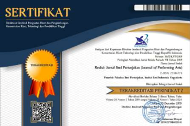Disrupsi dalam Musik
Abstract
Disrupsi identik dengan keadaan khaos bagi manusia akibat perkembangan teknologi; utamanya gagasan mesin menggantikan manusia. Musik yang merupakan bagian dari kehidupan manusia tidak luput dari khaos yang dihasilkan oleh disrupsi. Karena keadaan khaos itu tidak mengherankan bila banyak orang menduga bahwa disrupsi tidak mungkin memiliki kerangka pikir yang jelas. Tulisan ini, dengan mengadaptasi pemikiran di dalam ilmu teknik berhasil memformulasikan sebuah metodologi untuk memahami disrupsi di dalam musik. Metodologi itu memiliki tiga aspek di dalamnya, yaitu aspek horizontal yang berbicara mengenai percampuran genre musik dengan genre seni lainnya, aspek vertikal yang berbicara mengenai percampuran di dalam genre musik, dan aspek aksiologis yang berbicara mengenai hubungan musik dengan bidang-bidang lain yang bersifat non-musik. Metodologi disrupsi di dalam musik memperlihatkan bahwa disrupsi bukan masalah yang besar; disrupsi merupakan sesuatu yang melekat di dalam musik. Disrupsi adalah sesuatu yang hakiki di dalam musik. Ia tidak mengancam musik, tetapi merupakan sebuah situasi yang memperkaya musik dalam hubungannya dengan dirinya sendiri dan bidang-bidang lain yang bersifat seni maupun non-seni.
Disruption in Music. Disruption is identical to chaotic state which is disrupted by the advance of technology especially with its notion of machine replaces men in work. It is said that music as part of men’s life are not immune from those chaotic states. Because of its seemingly chaotic state, it is not surprising that no one thought of disruption as having a clear methodology. By adopting a methodology of technical engeneering, this paper has succeded in forming a methodology which is able to explain musical disruption. This methodology has three aspects, i.e.: horizontal aspect which is about the mixing of musical genre with other art genres; vertical aspect which is about the the mixing of subgenres in musical genre; and axiological aspect which is about the interaction between music and non-music disciplines. The method of disruption in music shows that disruption is not a big problem; disruption is something inherent in music. Disruption is something essential in music. It does not pose a real threat to music; it is a condition which enriches the music in its relations to itself, other arts and non-music disciplines.
Keywords: music disruption; liberal arts
Keywords
Full Text:
PDFReferences
Bower, C. M. (2002). The transmission of ancient music theory into the Middle Ages. In T. Christensen (Ed.), The Cambridge History of Western Music Theory (pp. 136–167). Cambridge: Cambridge University Press. https://doi.org/10.1017/CHOL9780521623711.007
Cooper, B. L. (1991). Popular music perspectives: Ideas, themes, and patterns in contemporary lyrics. Ohio: Popular Press.
Dru, J.-M. (2007). How disruption brought order: the story of a winning strategy in the world of advertising. New York, N.Y: St. Martin’s Press.
Hicks, A. J. (2017). Composing the World: Harmony in the Medieval Platonic Cosmos. New York: Oxford University Press.
Hsu, H. (2017). Identity and Intention The New Yorker. The New Yorker, 93(28), 69.
Hughes, D., Evans, M., Morrow, G., & Keith, S. (2016). The New Music Industries: Disruption and Discovery. United States: Palgrave Macmillan. https://doi.org/10.1007/978-3-319-40364-9
Irawati, E. (2017). Transmisi Kelentangan dalam Masyarakat Dayak Benuaq. RESITAL: JURNAL SENI PERTUNJUKAN, 17(1).
Johnson, R., & Stahl, W. H. (1971). The quadrivium of Martianus Capella: Latin traditions in the mathematical sciences, 50 BC-AD 1250 (Vol. 1). New York: Columbia University Press.
Karl, E. P. S. (1991). Sejarah Musik Jilid 1. Pusat Musik Liturgi. Jogjakarta: Pusat Musik Liturgiy.
Laksono, K. L., Anggreni Purba, S., & Dona Hapsari, P. (2015). Musik Hip-Hop sebagai Bentuk Hybrid Culture dalam Tinjauan Estetika. RESITAL: JURNAL SENI PERTUNJUKAN, 16(2).
Little, M., & Jenne, N. (2001). Dance and the Music of JS Bach. Tucson: Indiana University Press.
Machin, D. (2010). Analysing popular music: Image, sound and text. Sweden: Sage Publications.
Marshall, S. (1994). Jean, Jazz Dance–The Story of American Vernacular Dance. New York: Da Capo Press.
Middleton, R. (2000). Reading Pop: Approaches to Textual Analysis in Popular Music: Approaches to Textual Analysis in Popular Music. Oxford University Press, USA.
North, A. C., & Davidson, J. W. (2013). Musical taste, employment, education, and global region. Scandinavian Journal of Psychology, 54(5), 432–441.
Prasetyo, H. (2018). Indrustri 4.0: Telaah Klasifikasi Aspek dan Arah Perkembangan Riset. J@ Ti Undip: Jurnal Teknik Industri, 1(1), 17–26.
Stamatellos, G. (2012). Introduction to Presocratics: a thematic approach to early Greek philosophy with key readings. United States of America: John Wiley & Sons.
Suwardana, H. (2018). Revolusi Industri 4.0 Berbasis Revolusi Mental. Jurnal Ilmiah Teknik Dan Manajemen Industri, 1(2), 102–110. https://doi.org/http://ojs.unik-kediri.ac.id/index.php/jatiunik/article/view/117/0
Vernallis, C. (2004). Experiencing music video: aesthetics and cultural context. United States of America: Columbia University Press.
DOI: https://doi.org/10.24821/resital.v18i3.3337
Refbacks
- There are currently no refbacks.
This work is licensed under a Creative Commons Attribution 4.0 International License.



